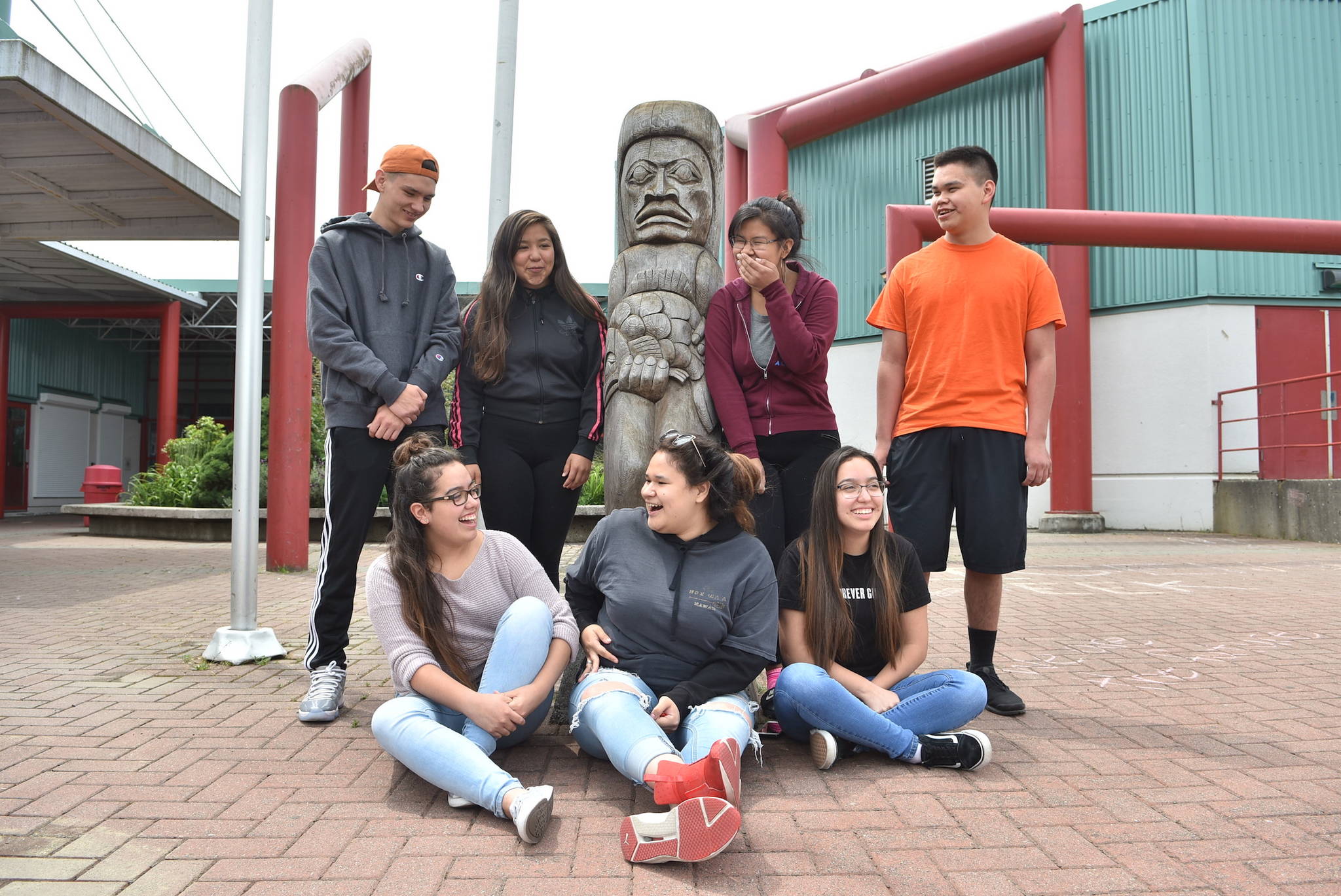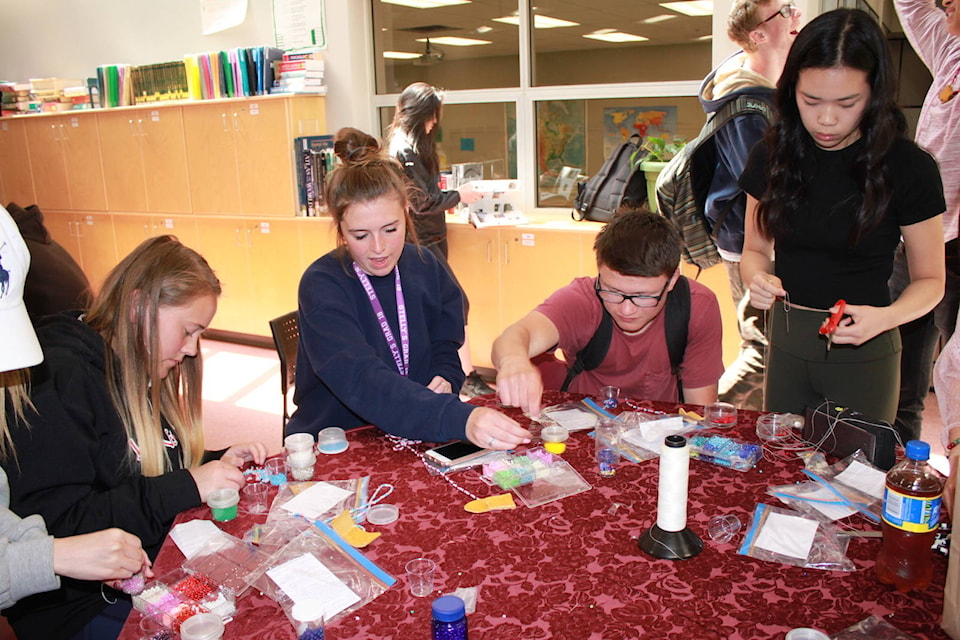In June, the Peninsula News Review spoke to students of Stelly’s Indigenous Leadership class at the end of Indigenous Celebration Week, held May 28-June 1, 2018. Students demonstrated their culture by playing games, singing songs and making crafts, but they also discussed sombre topics like the epidemic of missing and murdered Indigenous women and girls. We asked them to reflect on the week and what it means to be a young Indigenous person today. Here is a small sampling of what they had to say.
What was the purpose of Indigenous Celeration Week?
Damon Underwood: That week we really focused on the beauty and the positives of our culture rather than trying to get past I guess you could say, speed bumps? We really focused on trying to represent ourselves and everyone who we have in our community and the beauty of our culture.
Sythlumaut (Kendra Page): On Monday we did some cultural singing, because I come from a family where we do Tzinquaw dancing. I taught songs from here in W̱SÁNEĆ and we taught a song from Natalya and Kiara’s home (Kwakwaka’wakw).
Can you describe the Indigenous Leadership course?
Tlakwelgenaxw (Natalya Child): Basically, we try to meet once and week and talk about the goals and things we want people of our school to learn, whether it’s SENĆOŦEN, or even just bringing awareness in general to our cultures.
What made you decide to sign up?
Sythlumaut (Kendra Page): I signed up because it was kind of scary when I first came to Stelly’s. I just felt alone because I moved from W̱SÁNEĆ Leadership Secondary School and we were all family there. You knew everybody one way or another. Everything you did, [you] did together. But when [I] moved here, it was just, like, [I] didn’t know who to feel close to. In signing up for leadership, you can have people that know where you’re coming from and you can feel just, connected with them in that way. You guys all want the same thing: to bring our culture together and teach other people your background.
Xalanamut (Danielle Jack): It was, like, really powerful to have us there (together). Before, none of us would really talk. But once we got to know each other more, we actually kind of became a family, and that was really interesting.
Damon Underwood: Even here, I got a lot of, ‘Oh, you’re Native, you’re not smart.’ Or, ‘You’re Native, you don’t know what you’re talking about.’ And in joining this Indigenous leadership course, my main goal was to just, prove them all wrong. Show them who we are, what we’re about. We call ourselves “The People Place” (the Stelly’s motto), then why not show it?
How did the non-Indigenous students respond to Celebration week?
Tlakwagila’ogue (Kiara Child): Many people tried the activities. When it came to the Lahal (bone game), there was a pretty good mixture of people playing. It was exciting to see so many people participate that weren’t just Indigenous students.
Underwood: Every once in a while we had a weird look, people look over, kind of give it a judging smirk, shake it off and walk away. But in all fairness, you can’t force that into everyone’s brain. If it was the way they were raised then so be it. I look it as, if you can make this many people’s day, and there’s still that one person that doesn’t want to learn, that’s their right. As long as they’re respectful about it…I saw people trying to sing along, and couldn’t help but smile, couldn’t help but record it all and have it as a memory.
Tlakwagila’ogue: At the same time, I feel like students are hesitant to join into activities because it’s kind of like, ‘Oh yeah, that’s their thing.’ That’s another barrier that’s kind of split people apart.
Leilani Sampson: I’ve heard a lot of times that, ‘Oh, am I allowed in that room?’ because it’s the cultural room or the First Nations room.
Sythlumaut: The whole point of last week was to let people know they’re welcome in the things we do. We tried to make signs for letting people know what we’re doing and they’re allowed to come join us. We let people know through the PA system.
Why do you think some students hesitated to join in?
Underwood: For a long time, because of everything from the past that happened to our people, we were told: “What is with us still, that’s sacred, you don’t let that go to anybody. You hold that inside. [Those are] your teachings. You don’t go telling that to everybody else.” Until just recently, when everyone in the community started saying, “let people know, let people know who we are, how beautiful our culture is. Welcome them into it.” You can teach them, but there’s still the things that you keep very sacred.
Have you noticed a shift in attitude over the years you’ve been in public school?
Underwood: I’ve been in public school since kindergarten, and I dealt with a lot. It started with racism as early as Grade 1 and it was brutal. I lived in the office because of how many fights I was getting in. It just felt like that was the only way I was able to stick up for myself…I went to ḰELSET Elementary School and that’s where it got really rough, honestly, but I had that little [bit of] hope because there was the First Nations room there, and I would always go there. Came [to] Bayside and I was introduced to the actual class for SENĆOŦEN and that really helped me find myself. And then from there on I was just super passionate about it. The change from even my Grade 1 year to now, it’s amazing. I see so many more open hands to it.
What should be changed?
Sampson: I think society could work on their open mindedness and [acceptance], but there’s so many people that have said that and have tried. You know, there’s just some people out there that were raised in communities that just were so…discriminative. If you’re raised with only one type of people in front of your face, right there, you see them every day, and then one day you go out and you travel somewhere. Maybe you’re a high school student and you grew up in a really small community, where you see people every day that you know and you trust them and then you go into a more diverse, larger town and you just don’t know how to like, face it, so you just…okay I don’t know where I’m going with that, I’m sorry.
Voice: Awww, I liked that.
Sampson: Awww, okay. [Laughter]
Underwood: I think the biggest thing that I feel needs to be changed is I think the BCFN12 course needs to be mandatory. I’m strongly behind that. I think it needs to be mandatory because…in order for me to graduate I need to learn someone else’s culture. We are the Indigenous people. Why don’t they have to learn our culture?
What’s the difference between BCFN 12 and your leadership class?
Sampson: There was nothing really to connect with on a personal level (in BCFN 12) and in this class there’s a large difference in the subject matter that is getting taught. It’s more real, it’s more honest, it’s just us being us and not somebody else’s — because what’s in the textbook isn’t our perspective at all. And it’s really outdated.
Any parting thoughts?
Sythlumaut: I think I want this to be well known. Even though we’re from different places, we’re all pushing for the same thing, right? I want people to know that there’s people in the W̱SÁNEĆ territory that are, they’re a younger generation trying to fight for our cultural rights in schools and out of it. And it’s not just the adults doing it.
Sythlumaut: Not one person is going to be able to fix this all, but every little thing you give in, to make a change, is definitely worth it because we’ve started something, that somebody else is probably going to finish…It could be my little brother. Your little brother! But, everything we hand in here is going to, going change something in the future.
Sampson: It’s a hard thing, because you kind of have to accept yourself. You know?
Sythlumaut: Leilani!
Sampson: I’m sorry, did I ruin that?
[Laughter]
Underwood: I’m really hoping to come back and just you know, if it’s every Tuesday, just help out. I’ve talked about this class to younger kids. elementary school kids and they say they’re super excited to get here just cause they wanted to be in it.
Sythlumaut: Just because an event or a class has a label that involves Indigenous or some word like that, it’s not a restriction. To me, it’s more of a recognition of, I don’t know where I was trying to get to, but it’s like a welcoming space. And I feel like that’s what Indigenous can stand for. And that’s why sometimes I feel that I’m proud to use the word Indigenous when I introduce myself.
This conversation has been edited and condensed.
RELATED: Bayside Indigenous students find their voice

